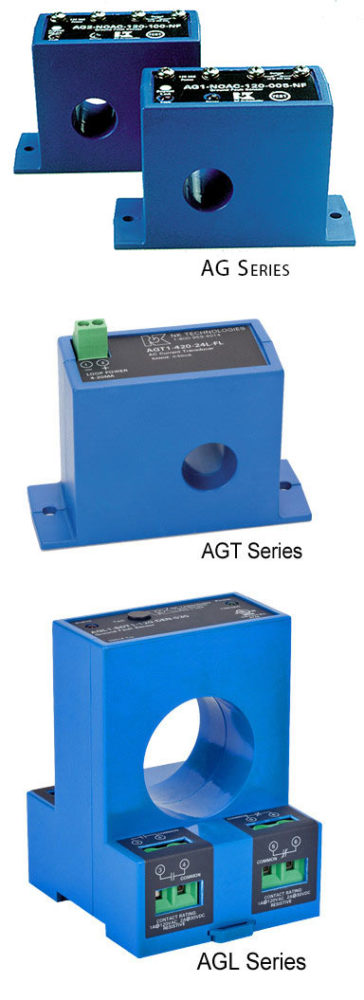 NK Technologies has been manufacturing ground fault and residual current relays for over two decades with a wide variety of models to suit specific applications. With such a wide variety available, it can be complicated to select the appropriate model. We hope this short guide will help you navigate through the model selection.
NK Technologies has been manufacturing ground fault and residual current relays for over two decades with a wide variety of models to suit specific applications. With such a wide variety available, it can be complicated to select the appropriate model. We hope this short guide will help you navigate through the model selection.
How large are the conductors feeding the monitored load? Our ground fault relays will not “see” any current under normal conditions, but all current carrying conductors must be able to pass through the relaying window. If the wires are #6 AWG or smaller, whether using two, three, or four wires, the AG relay will work. If larger wire is used, up to 300 MCM, the AGL series will allow the wires to pass through the relaying window.
What will the sensor contact do in your control system? Since NK Technologies’ relays do not provide a circuit disconnect, they generally perform one of two functions: Close a circuit to energize a shunt trip breaker operating mechanism or, control the coil of a contactor (or relay).
Shunt trip operation: If the monitored load is less than 50 amps, we recommend the AG1-SDT1-120- DEN-030. The N.O. contact is used to close the circuit powering the shunt trip breaker accessory. This model uses nominal 120 VAC from a separate source for sensor power. The contacts return to the original state once the breaker opens and the fault is no longer detectable.
Contactor or relay operation: The same relay, AG1, can be used to operate a contactor coil, but we recommend a latching output model to simplify the installation: AG1-NCR1-120-LA-030. This relay will open the circuit powering the contactor coil and the contact will stay open until an external reset button is pressed.
A similar model number construction format is used for the larger AGL units, so shunt trip breaker applications would use AGL1-SDT1-120-DEN-030, and contactor applications would use the AGL1-NCR1-120-LA-030.
What is the power supply that will be used? If you do not have access to 120 VAC for power, NK Technologies offers relays designed for 24 VAC or DC operation. Change “120” to “24U” in the model number.
Do you need a trip point higher or lower than 30 mA? Change the suffix in the model number from “030” to “005” (5 mA), up to 100 (100 mA). Higher still? Use AG2 (or AGL2) for trip points from 80 to 950 mA.
Would the application benefit from “fail-safe” contact action? This energizes the output relay as soon as power is applied to the relay terminals. The contacts return to their original condition if power is removed from the relay or a fault is detected. Change “DEN” to “ENE” in the model number. Fail-safe operation is not available with the latching output models.
Would a solid-state “contact” be preferred over a mechanical relay contact? We do offer them, but we suggest calling our factory technical support for guidance.
Need some time delay or an easily adjustable trip point? Take a look at the AGLD series for these features.
Need to monitor a primary circuit larger than 300 amps? Call the factory, and we will help with that too!

